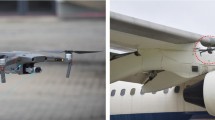Abstract
The traditional aircraft skin inspection is mainly manual inspection, which has low efficiency, large workload, and is prone to missed and misdetected inspections. In order to improve the efficiency of aircraft skin detection, an end-to-end aircraft skin damage detection method based on Ghostnet is proposed. By introducing a scale factor to adjust the convolution method in Ghostnet, the multi-scale feature extraction module extracts the texture features of aircraft skin, which increases the range of receptive fields in the backbone network. Secondly, a multi-layer feature fusion module is introduced to integrate shallow and deep features. The angular margin is introduced to improve the confidence function to improve the confidence of each damage category. Based on the self-made data containing 1730 pieces of aircraft skin damage, the detection accuracy of the model can reach 89.28%, the detection speed is 36 frames per second, and the detection accuracy is improved by 9.28%.
Access this chapter
Tax calculation will be finalised at checkout
Purchases are for personal use only
Similar content being viewed by others
References
Zhang, W., Wang, M.D., Fan, J.L., et al.: Progress and prospect of the application of machine vision in aircraft structural damage detection.Nondestr. Test. 43(10), 75–80 (2021)
Obadimu, S.O., Karanikas, N., Kourousis, K.I.: Development of the minimum equipment list: current practice and the need for standardization. Aerospace 7(1), 7 (2020)
Yasuda, Y.D., Cappabianco, F.A., Martins, L.E.G., Gripp, J.A.: Aircraft visual inspection: a systematic literature review. Comput. Ind. 141(15), 103695 (2022)
Tang, L.: Research on Inspection of Damaged Fasteners for Aircraft Skin Based on Convolutional Neural Network, Nanjing University of Aeronautics and Astronautics (2020)
Anil, D., Soufiane, B., Ridwan, A.: Using convolutional neural networks to automate aircraft maintenance visual inspection. Aerospace 7(12), 171 (2020)
Ramalingam, B., Manuel, V.H., Elara, M.R., et al.: Visual inspection of the aircraft surface using a teleoperated reconfigurable climbing robot and enhanced deep learning technique. Int. J. Aerosp. Eng. 2019(1), 1–14 (2019)
Wang, T., Wang, H.W., Wang, H.: Aircraft skin damage detection based on rotating object detection. Laser Optoelectron. Prog. 60, 1–14 (2023)
Hussey, T.B.: Surface Defect Detection in Aircraft Skin & Visual Navigation based on Forced Feature Selection through Segmentation, Air Force Institute of Technology (2021)
Yu, F., Koltun, V.: Multi-Scale Context Aggregation by Dilated Convolutions, Computer Vision and Pattern Recognition, 30 Apr 2016. https://arxiv.org/abs/1511.07122
Han, K., Wang, Y., Tian, Q., et al.: GhostNet: more features from cheap operations. In: 2020 IEEE/CVF Conference on Computer Vision and Pattern Recognition, IEEE (2020)
Yin, Q., Yang, W.: FD-SSD: an improved SSD object detection algorithm based on feature fusion and dilated convolution. Sig. Process. Image Commun. 98, 116402 (2021)
Wang, F., Liu, W., Liu, H., et al.: Additive margin softmax for face verification. Comput. Vis. Pattern Recogn. 25–7, 926–930 (2018)
Adres, B.: A319/A320/A321 Aircraft Maintenance Manual. Airbus Industrie
Raven, O.: Boeing 737-300/400/500 Aircraft Maintenance Manual. The Boeing Company
Wang, C.Y., Bochkovskiv, A., Liao, H.: YOLOv7: Trainable bag-of-freebies sets new state-of-the-art for real-time object detectors, arXiv e-prints (2022)
Zhou, X., Wang, D.: Objects as points. Comput. Vis. Pattern Recogn. 12 (2019)
Author information
Authors and Affiliations
Corresponding author
Editor information
Editors and Affiliations
Rights and permissions
Copyright information
© 2024 Chinese Society of Aeronautics and Astronautics
About this paper
Cite this paper
Hao, W., Jia, L., Fu, L. (2024). End-To-End Aircraft Skin Damage Detection Method Based on Ghostnet. In: Proceedings of the 6th China Aeronautical Science and Technology Conference. CASTC 2023. Lecture Notes in Mechanical Engineering. Springer, Singapore. https://doi.org/10.1007/978-981-99-8864-8_25
Download citation
DOI: https://doi.org/10.1007/978-981-99-8864-8_25
Published:
Publisher Name: Springer, Singapore
Print ISBN: 978-981-99-8863-1
Online ISBN: 978-981-99-8864-8
eBook Packages: EngineeringEngineering (R0)




